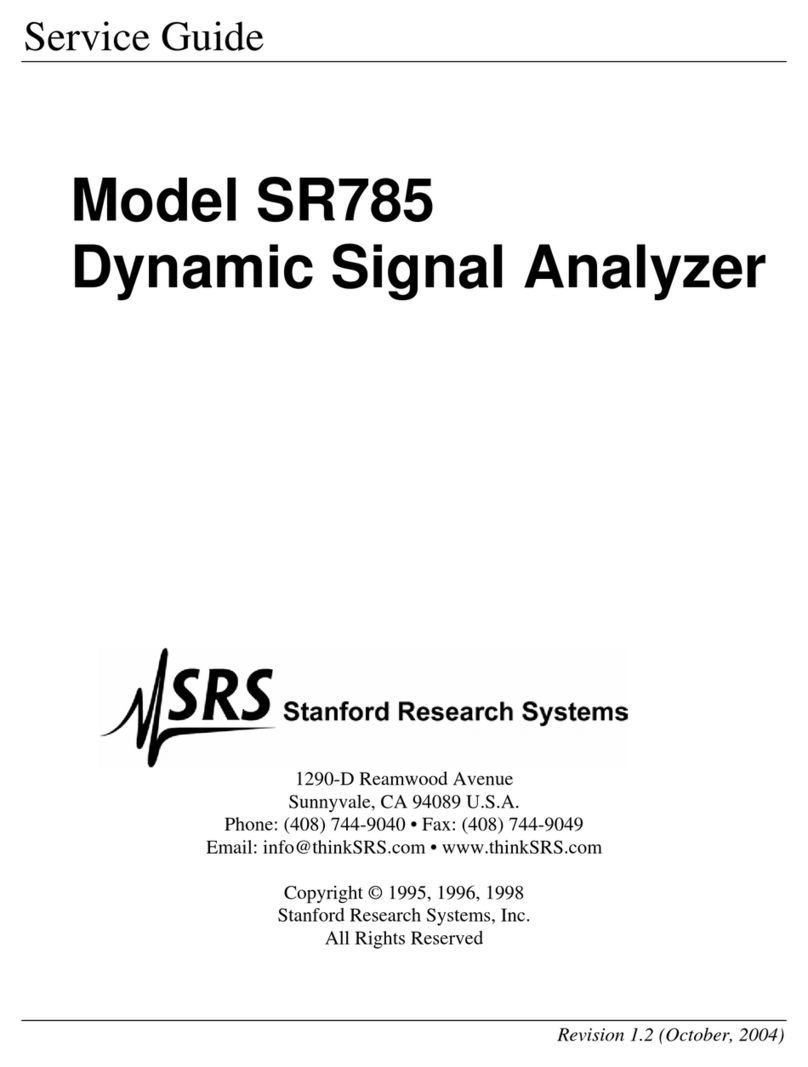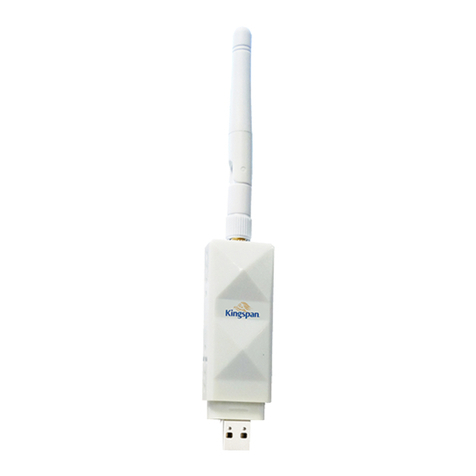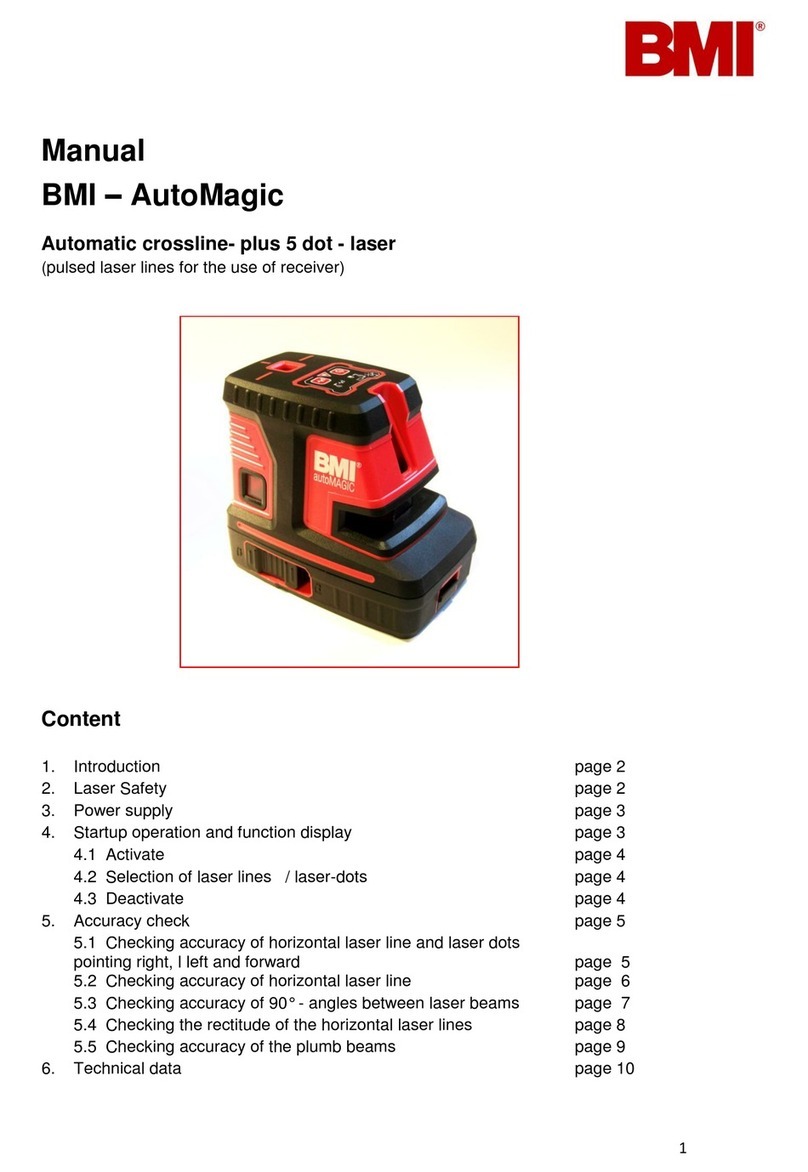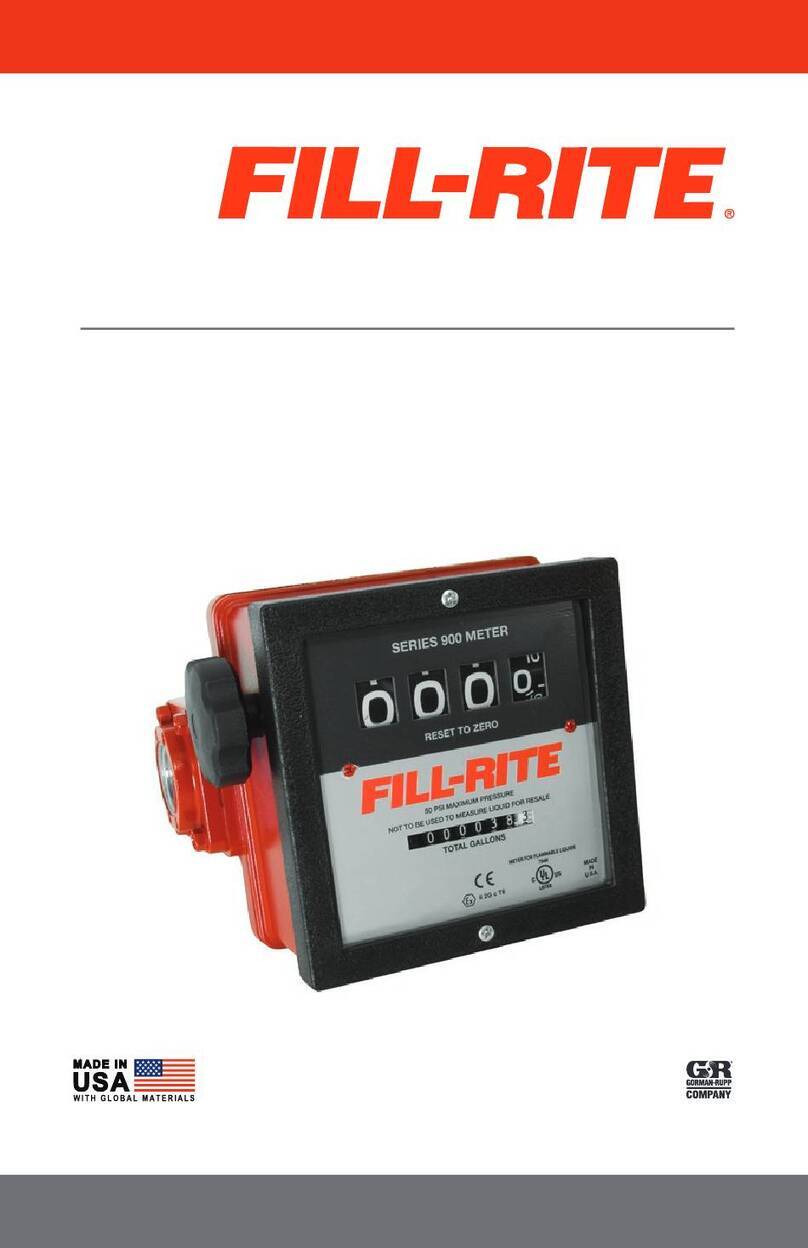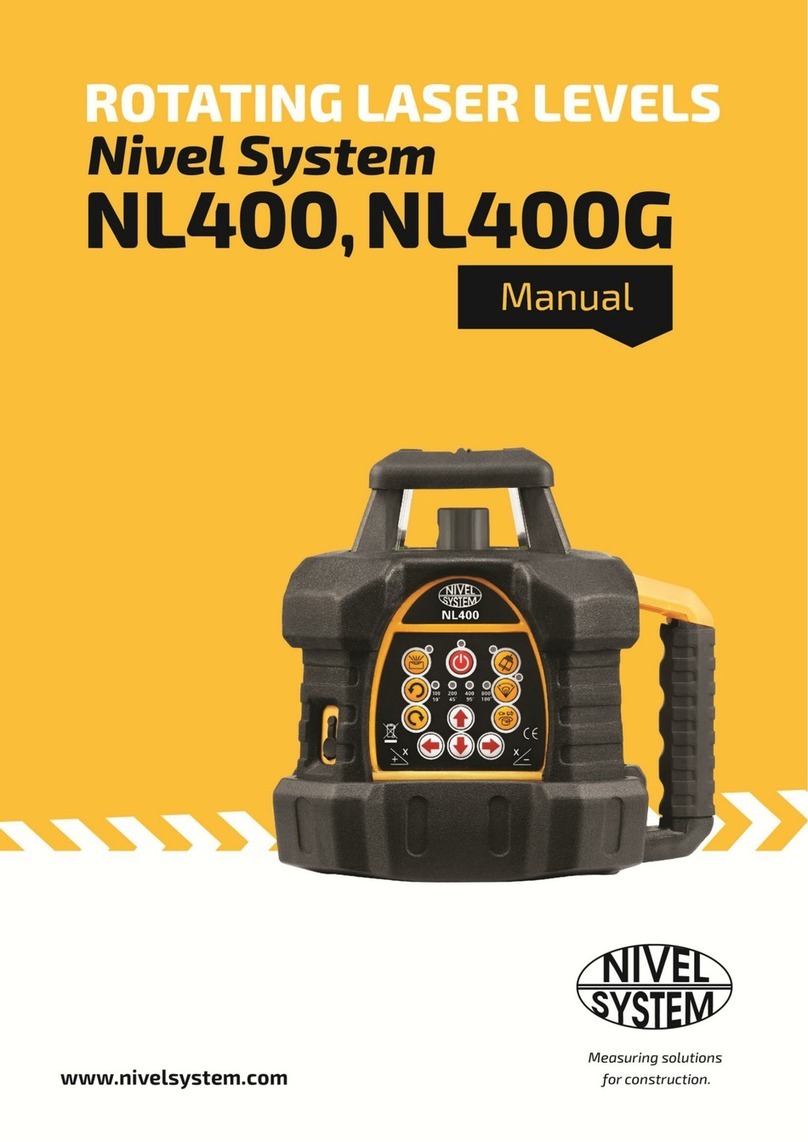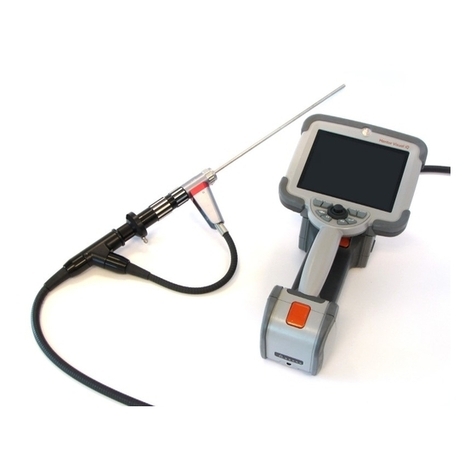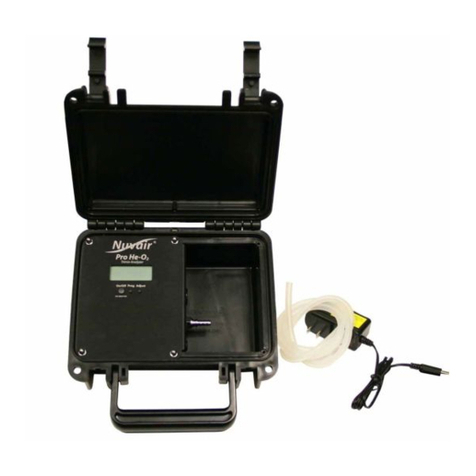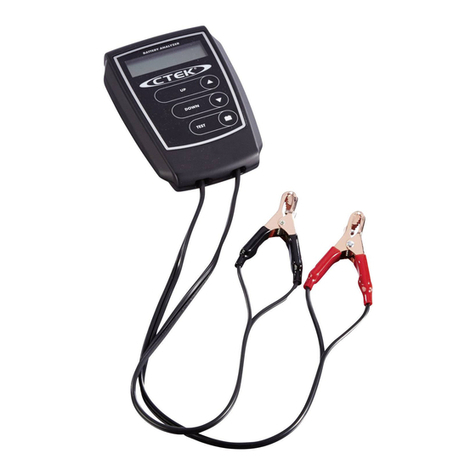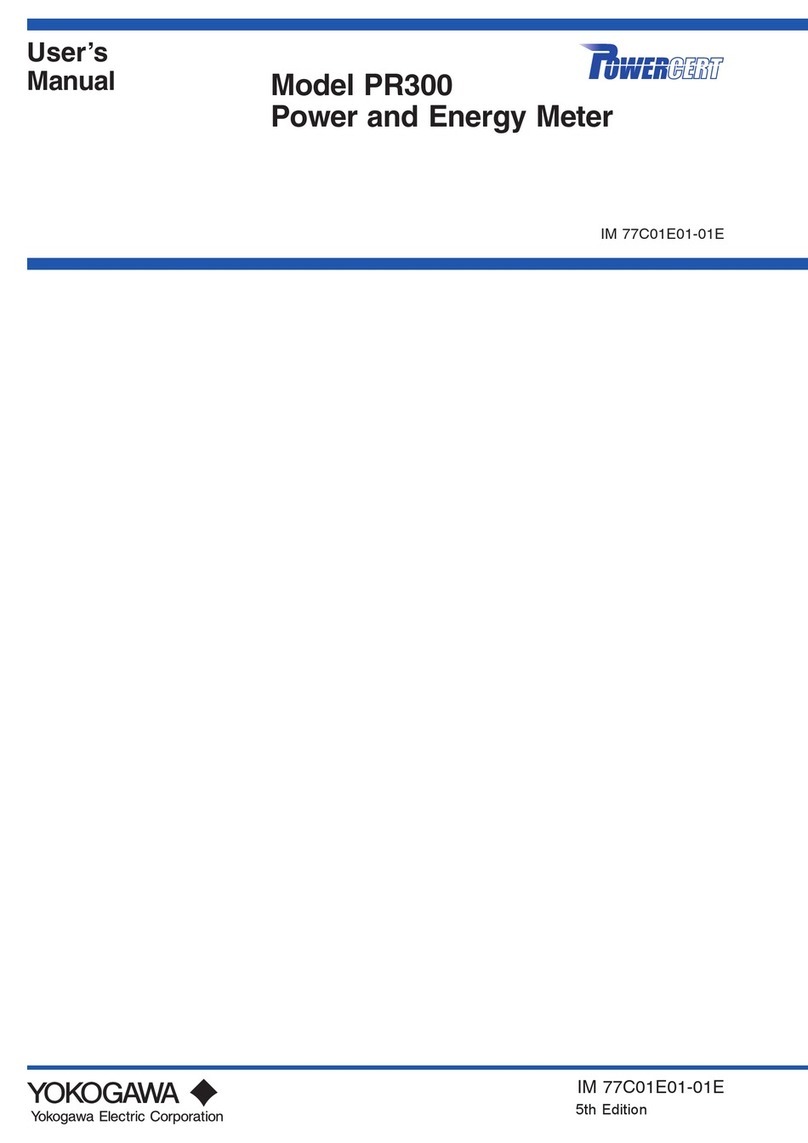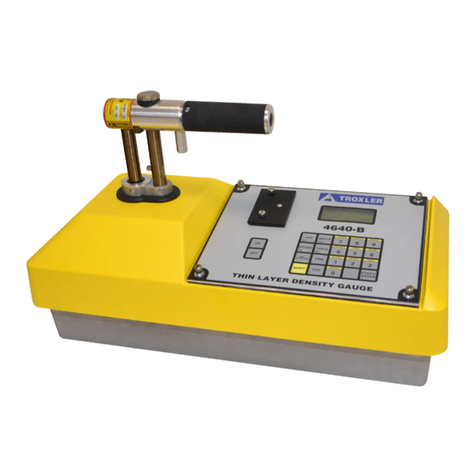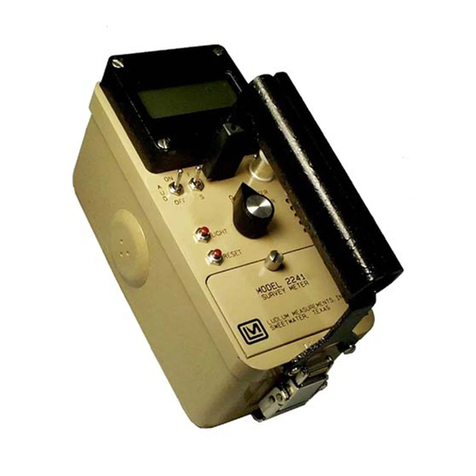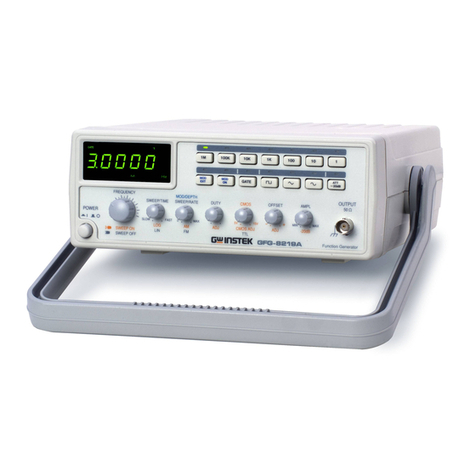SRS Labs SIM940 Operation manual

Operation and Service Manual
Rubidium Frequency Standard
SIM940
Stanford Research Systems
Revision 1.3 •May 8, 2007

Certification
Stanford Research Systems certifies that this product met its published specifications at the time
of shipment.
Warranty
This Stanford Research Systems product is warranted against defects in materials and workman-
ship for a period of one (1) year from the date of shipment.
Service
For warranty service or repair, this product must be returned to a Stanford Research Systems
authorized service facility. Contact Stanford Research Systems or an authorized representative
before returning this product for repair.
Information in this document is subject to change without notice.
Copyright c
Stanford Research Systems, Inc., 2003, 2007. All rights reserved.
Stanford Research Systems, Inc.
1290–D Reamwood Avenue
Sunnyvale, CA 94089 USA
Phone: (408) 744-9040 •Fax: (408) 744-9049
Printed in U.S.A. Document number 9-01568-903
SIM940 Rubidium Frequency Standard

Contents
General Information iii
Service .............................. iii
Symbols ............................. iv
Specifications .......................... vi
1 Overview 1 – 1
1.1 Introduction to the Instrument . . . . . . . . . . . . . 1 – 2
1.2 Quick Start Guide . . . . . . . . . . . . . . . . . . . . . 1 – 3
1.3 SIMInterface........................ 1–5
2 Operation 2 – 1
2.1 Power............................ 2–2
2.2 Warm-up.......................... 2–2
2.3 Connection to other instruments . . . . . . . . . . . . 2 – 2
2.4 Connection to SRS Instruments . . . . . . . . . . . . . 2 – 3
2.5 Direct Frequency Control of the SIM940 . . . . . . . . 2 – 4
2.6 Using an External 1 pps Reference . . . . . . . . . . . 2 – 5
3 Monitor and Control 3 – 1
3.1 Setting up communications . . . . . . . . . . . . . . . 3 – 2
3.2 Getting connected . . . . . . . . . . . . . . . . . . . . . 3 – 2
3.3 Testing connection . . . . . . . . . . . . . . . . . . . . 3 – 3
3.4 Connecting to the SIM940 . . . . . . . . . . . . . . . . 3 – 3
3.5 Terminal program . . . . . . . . . . . . . . . . . . . . . 3 – 4
3.6 RubidiumStats ...................... 3–5
3.7 RbMon menus........................ 3–8
i

ii Contents
4 Calibration 4 – 1
4.1 With a frequency counter . . . . . . . . . . . . . . . . . 4 – 2
4.2 With a 1 pps reference . . . . . . . . . . . . . . . . . . 4 – 4
4.3 Calibration of the time-tag offset parameter . . . . . . 4 – 6
5 Circuitry 5 – 1
5.1 Circuit Discussion . . . . . . . . . . . . . . . . . . . . . 5 – 2
5.2 Component parts list . . . . . . . . . . . . . . . . . . . 5 – 5
5.3 Schematic Diagrams . . . . . . . . . . . . . . . . . . . 5 – 5
Addendum: PRS10 Manual
SIM940 Rubidium Frequency Standard

General Information
The SIM940 Rubidium Frequency Standard, part of Stanford Re-
search Systems’ Small Instrumentation Modules family, is a 10 MHz
frequency standard with an estimated 20-year aging of less than
0.005 ppm.
Service
Do not install substitute parts or perform any unauthorized modifi-
cations to this instrument.
The SIM940 is a double-wide module designed to be used inside the
SIM900 Mainframe. Do not turn on the power until the module is
completely inserted into the mainframe and locked in place.
iii

iv General Information
Symbols you may Find on SRS Products
Symbol Description
Alternating current
Caution - risk of electric shock
Frame or chassis terminal
Caution - refer to accompanying documents
Earth (ground) terminal
Battery
Fuse
On (supply)
Off (supply)
SIM940 Rubidium Frequency Standard

General Information v
Notation
The following notation will be used throughout this manual:
•Front-panel indicators are set as Overload.
•Remote command names are set as ID?.
•Literal text other than command names is set as OFF.
SIM940 Rubidium Frequency Standard

vi General Information
Specifications
Performance Characteristics
Output Output frequency 10 MHz sine,
10 µs wide 1 pps pulse
Amplitude (±10 %) 0.5 Vrms (+7 dBm) into 50 Ω
1 pps pulse amplitude 2.5 V into 50 Ω, 5 V into high-Z
Noise Phase noise (SSB) <−130 dBc/Hz (10 Hz)
<−140 dBc/Hz (100 Hz)
<−150 dBc/Hz (1 kHz)
<−155 dBc/Hz (10 kHz)
Spurious <−100 dBc (100 kHz BW)
Harmonics <−60 dBc
Short term stability <2×10−11 (1 s)
(Allan variance) <1×10−11 (10 s)
<2×10−12 (100 s)
Accuracy Accuracy at shipment ±5×10−11
Aging (after 30 days) <5×10−11 (monthly)
<5×10−10 (yearly)
5×10−9(20 years, typ.)
Holdover 72 h Stratum 1 level
(1 ×10−11)
Frequency retrace ±5×10−11 (72 h off, then 72 h on)
Control Settability <5×10−12
Trim range ±2×10−9(0 to 5 VDC)
±0.5 ppm (remote interface)
Warm-up time <6 minutes (time to lock)
<7 minutes (time to 1 ×10−9)
SIM940 Rubidium Frequency Standard

General Information vii
Interfaces
Front-panel LEDs Locked Indicates frequency is lock to
rubidium
Unlocked Indicates frequency is unlocked
1 pps input Blinks with each 1 pps reference
input applied to rear panel
1 pps sync Indicates 1 pps output is
synchronized within ±1µs of
1 pps input
Rear Panel (BNCs) Frequency Adjust 0 to 5 VDC adjusts frequency
by ±0.002 ppm
1 pps input 100 kΩinput. Requires CMOS
level pulses (0 to 5 VDC). If an
external 1 pps input is applied, lock
is maintained between the 1 pps
input and 1 pps output with computer
adjustable time constant from 8 minutes
to 18 hours.
1 pps output 50 Ωpulse output
10 MHz outputs Three 50 ohm isolated 10 MHz
sine outputs
SIM (DB–15/male) power and communications
Operating Temperature +10 ◦C to +40 ◦C
Temperature stability ∆f/f<±1×10−10
(+10 ◦C to +40 ◦C)
Storage temperature −55 ◦C to +85 ◦C
Magnetic field ∆f/f<±2×10−10 for 1 Gauss
field reversal
Relative humidity 95 % (non-condensing)
General Characteristics
Interface Serial (RS-232) through SIM interface
Power +24 VDC
Supply current 2.2 A at start-up,
0.6 A after warm-up period
Weight 5 lbs
Dimensions 1.500 W×3.600 H×7.000 D
SIM940 Rubidium Frequency Standard

viii General Information
SIM940 Rubidium Frequency Standard

1 Overview
This chapter gives the necessary information to get started quickly
with the SIM940 Rubidium Frequency Standard.
In This Chapter
1.1 Introduction to the Instrument . . . . . . . . . . . . . 1 – 2
1.2 Quick Start Guide . . . . . . . . . . . . . . . . . . . . 1 – 3
1.3 SIMInterface ....................... 1–5
1.3.1 SIM interface connector . . . . . . . . . . . . . 1 – 5
1.3.2 Direct interfacing . . . . . . . . . . . . . . . . . 1 – 5
1–1

1–2 Overview
1.1 Introduction to the Instrument
The SIM940 is a 10 MHz frequency standard with an estimated 20-
year aging of less than 0.005 ppm. The module integrates an SRS
PRS10 Rubidium Frequency Standard in a standard double-width
SIM module. The module’s low aging eliminates the need for an ex-
ternal frequency reference in many applications; however moduless
can phase-lock to an external 1 pps signal (such as GPS) for ageless
performance or periodic calibration as required.
The SIM940 provides exceptionally low phase noise 10 MHz sine
outputs as well as a low-jitter 1 pps output. The three 10 MHz outputs
have a phase noise of <−130 dBc/Hz at 10 Hz offset from carrier,
dropping to <−155 dBc/Hz at 10 kHz offset. The Allan variance is
less than 2 ×10−11 at one second and 2 ×10−12 at 100 seconds. The
1 PPS OUT outputhas less than 1 ns of jitter and may be set with 1 ns
resolution.
An asynchronous serial interface allows for direct communication
with internal PRS10 frequency standard via the SIM900 mainframe.
This interface is used for frequency calibration, 1 pps timing and
status determination. A Windows application program is provided.
The SIM940 will time-tag the rising edge of a user supplied 1 pps
input, which usually comes from a GPS receiver. The module can
phase-lock to this input to cancel long-term aging. The time-tag
results may be read back via the serial interface. Timing is referenced
to the leading edge of the 1 pps output pulse. The 1 pps output
pulse will be moved into coincidence with the user supplied 1 pps
input after 256 input pulses. Thereafter, the SIM940 will adjust its
frequency to maintain the phase lock between the 1 pps input and the
1 pps output. The phase lock algorithm uses an adjustable natural
time constant (from 8 minutes to 18 hours) which may be adjusted
via the serial interface.
Several thousand PRS10’s have been operating in various OEM appli-
cations with a demonstrated MTBF several hundred thousand hours
and so a malfunction of the PRS10 is very unlikely. In the event of a
failure of the “physics package” the 10 MHz output will be provided
by the unit’s ovenized SC-cut 10 MHz crystal oscillator with typical
aging of 0.05 ppm/year.
The SIM940 will find application as an autonomous frequency stan-
dard in virtually any calibration or R&D laboratory where precision
time or frequency measurements are made, or in any other situations
requiring an accurate frequency standard. The low cost of the unit,
together with its extremely low aging, will allow customers to deploy
precision frequency references without the need to install cables or
SIM940 Rubidium Frequency Standard

1.2 Quick Start Guide 1–3
antennas.
1.2 Quick Start Guide
1. Turn offthe SIM900 mainframe.
2. Install the SIM940 in the SIM900 mainframe. (Use slots #7
& #8 if available for best thermal environment and shortest
connection for 10 MHz to SIM900 timebase input.)
3. To lock the SIM900 mainframe timebase to the SIM940 Rubid-
ium Frequency Standard, connect a SIM940 10 MHz output to
the SIM900 mainframe Timebase input with a short BNC cable.
4. Turn on the SIM900 mainframe.
5. The SIM940 should indicate Locked within six minutes.
SIM940 Rubidium Frequency Standard

1–4 Overview
Figure 1.1: The SIM940 front and rear panels.
SIM940 Rubidium Frequency Standard

1.3 SIM Interface 1–5
1.3 SIM Interface
The primary connection to the SIM940 Rubidium Frequency Stan-
dard is the rear-panel DB–15 SIM interface connector. Typically, the
SIM940 is mated to a SIM900 Mainframe via this connection, either
through one of the internal mainframe slots, or the remote cable
interface.
It is also possible to operate the SIM940 directly, without using the
SIM900 Mainframe. This section provides details on the interface.
1.3.1 SIM interface connector
The DB–15 SIM interface connector carries all the power and commu-
nications lines to the instrument. The connector signals are specified
in Table 1.1
Direction
Pin Signal Src ⇒Dest Description
1 SIGNAL GND MF ⇒SIM Ground reference for signal
2−STATUS SIM ⇒MF Status/service request (GND=asserted, +5V=idle)
3 RTS MF ⇒SIM HW Handshake (unused in SIM940)
4 CTS SIM ⇒MF HW Handshake (unused in SIM940)
5−REF 10MHZ MF ⇒SIM 10 MHz reference (unused in SIM940)
6−5V MF ⇒SIM Power supply (No connection in SIM940)
7−15V MF ⇒SIM Power supply (No connection in SIM940)
8 PS RTN MF ⇒SIM Power supply return
9 CHASSIS GND Chassis ground
10 TXD MF ⇒SIM Async data (start bit=“0”=+5 V; “1”=GND)
11 RXD SIM ⇒MF Async data (start bit=“0”=+5 V; “1”=GND)
12 +REF 10MHz MF ⇒SIM 10 MHz reference (unused in SIM940)
13 +5V MF ⇒SIM Power supply (No connection in SIM940)
14 +15V MF ⇒SIM Power supply (No connection in SIM940)
15 +24V MF ⇒SIM Power supply
Table 1.1: SIM Interface Connector Pin Assignments, DB-15
1.3.2 Direct interfacing
The SIM940 is intended for operation in the SIM900 Mainframe, but
users may wish to directly interface the module to their own systems
without the use of additional hardware.
The mating connector needed is a standard DB–15 receptacle, such as
Amp part # 747909-2 (or equivalent). Clean, well-regulated supply
voltages of +24,VDC must be provided, following the pin-out spec-
ified in Table 1.1. Ground must be provided on pins 1 and 8, with
SIM940 Rubidium Frequency Standard

1–6 Overview
chassis ground on pin 9. The −STATUS signal may be monitored
on pin 2 for a low-going TTL-compatible output indicating a status
message.
The SIM940 has no internal protection against reverse polarity, missing
supply, or overvoltage on the power supply pins.
1.3.2.1 Direct interface cabling
If the user intends to directly wire the SIM940 independent of the
SIM900 Mainframe, communication is usually possible by directly
connecting the appropriate interface lines from the SIM940 DB–15
plug to the RS-232 serial port of a personal computer.1Connect RXD
from the SIM940 directly to RD on the PC, TXD directly to TDS. In
other words, a null-modem style cable is not needed.
To interface directly to the DB–9 male (DTE) RS-232 port typically
found on contemporary personal computers, a cable must be made
with a female DB–15 socket to mate with the SIM940, and a female
DB–9 socket to mate with the PC’s serial port. Separate leads from
the DB–15 need to go to the power supply, making what is sometimes
know as a “hydra” cable. The pin-connections are given in Table 1.2.
DB–15/F to SIM940 Name
DB–9/F
10 → 3 TxD
11 → 2 RxD
5 Computer Ground
to P/S
15 → +24 VDC
1,8,9 → Ground (P/S return current)
Table 1.2: SIM940 Direct Interface Cable Pin Assignments
1.3.2.2 Serial settings
The serial port settings at power-on are: 9600 baud, 8–bits, no parity,
1 stop bit, and no flow control. The serial settings cannot be changed
on the SIM940.
1Although the serial interface lines on the DB-15 do not satisfy the minimum
voltage levels of the RS-232 standard, they are typically compatible with desktop
personal computers
SIM940 Rubidium Frequency Standard

2 Operation
Direct (local) control of SIM940 is described.
In This Chapter
2.1 Power............................ 2–2
2.2 Warm-up.......................... 2–2
2.3 Connection to other instruments . . . . . . . . . . . . 2 – 2
2.4 Connection to SRS Instruments . . . . . . . . . . . . 2 – 3
2.4.1 SIM900 Mainframe . . . . . . . . . . . . . . . . 2 – 3
2.4.2 SR620 Time Interval Counter . . . . . . . . . . 2 – 3
2.4.3 DS345 Synthesized Function Generator . . . . 2 – 3
2.4.4 DG535 Digital Delay Generator . . . . . . . . . 2 – 4
2.5 Direct Frequency Control of the SIM940 . . . . . . . 2 – 4
2.6 Using an External 1 pps Reference . . . . . . . . . . . 2 – 5
2–1

2–2 Operation
2.1 Power
The module is powered from the SIM900 mainframe, which accom-
modates any voltage in the ranges 90 VAC to 260 VAC with a fre-
quency in the range of 47 Hz to 63 Hz. In most applications, and for
best performance, the mainframe should be left “on” at all times. The
rubidium frequency standard is operating and outputs are available
whenever the mainframe is “on”.
The unit may also be powered by a user supplied +24 VDC power
supply capable of providing 2.2 A during warm-up and about 0.6 A
continuously. The +24 VDC should be applied to pin #15 and ground
should be applied to pins # 1, 8 & 9 (see section 1.3.2.1).
2.2 Warm-up
The Rubidium Oscillator status LED (either Unlocked or Locked)
will be on whenever power is applied to the unit. The status will
change from Unlocked to Locked within six minutes after power is
applied if the module is started from room temperature. Warm-up
and locking will take longer if the module is started from a lower
temperature. Locked indicates the unit is warmed up and its crystal
oscillator has been locked to the rubidium physics package.
The output frequency will be about 200 ppm below nominal when
power is first appllied to a cold module. The frequency will grad-
uatlly converge on 10 MHz as the module warms up. After about
4 minutes (typically) the unit will reach operating temperature
and lock the crystal oscillator to the rubidium hyperfine transition.
Within seven minutes, the module will be locked to within 0.001 ppm
of 10 MHz.
2.3 Connection to other instruments
All of the outputs on the rear of the SIM940 have a source impedance
of 50 Ωand are intended to drive 50 Ωloads. Since the outputs have a
source impedance of 50 Ω, termination into a 50 Ωload is not critical
in most applications. Generally, the amplitude will approximately
double if the output is not terminated into a 50 Ωload. Properly
terminating into a 50 Ωload will reduce channel-to-channel cross-
talk and will reduce the probability of multiple triggering on the
1 pps output.
If a single 10 MHz output is “daisy-chained” to several instruments it
will be important that all of the instruments have a high-impedance
(>1 kΩ) and that a 50 Ωterminator be placed at the far end of the line.
SIM940 Rubidium Frequency Standard

2.4 Connection to SRS Instruments 2–3
Generally, it is better practice to use a separate output to each instru-
ment to avoid cross-talk and amplitude variations due to uncertain
loading and standing waves along the line.
Many instruments which generate or measure precise frequencies
or time-intervals have a 10 MHz input, usually located on the rear
of the instrument. Most of these instruments accept a sine input
with the amplitude provided by the SIM940. Sometimes a rear panel
switch or front panel configuration menu is required to “tell” the
instrument to use the 10 MHz input as a reference instead of using
the instrument’s own time base. Improved accuracy can be achieved
by using the SIM940 as an external time base to all of the instruments
in a particular laboratory. In addition, all errors associated with the
calibration of an individual instrument’s time base are eliminated.
2.4 Connection to SRS Instruments
2.4.1 SIM900 Mainframe
The SIM900 will automatically sense the presence of a 10 MHz sine
wave or square wave signal at its rear panel “TIMEBASE IN” BNC
connector, and phase lock to it. For convenience, it is best to install the
SIM940 in the slot 7 position of the SIM900 (filling slots 7 & 8), so that
a short length of RG58 coax cable can tie one of the 10 MHz outputs
of the SIM940 to the SIM900 TIMEBASE IN. The “TIMEBASE” status
LED on the fron the the SIM900 should move from “Internal 10 MHz”
to “External Lock.”
2.4.2 SR620 Time Interval Counter
This instrument is “told” to use the external 10 MHz input via the
front panel CONFIG menu. To configure the SR620 to use an external
time base press the SEL key in the CONFIG section once to display
CONFIG menus, then press SEL one more time to select the
menu, which will flash when selected. Press the SET key twice to
access the submenu. Press the arrow keys
immediately to the left of the CONFIG menu (in the SCOPE AND
CHART section) to select , which is the rear panel time base
input. Press the SET key in the CONFIG section once more to verify
the expected time base frequency (5 MHz or 10 MHz). Press the
arrow keys to select 10 MHz.
2.4.3 DS345 Synthesized Function Generator
The DS345 automatically detects the application of an external time
base and phase locks to it. After applying a 10 MHz sine to the rear
panel time base input, a front panel indicator will turn “on.”
SIM940 Rubidium Frequency Standard

2–4 Operation
2.4.4 DG535 Digital Delay Generator
A rear panel switch is used to specify an external 10 MHz time base
input. Some revisions of the DG535 required a 10 MHz square wave
input, and may not operate properly with the 10 MHz sine wave
output from the SIM940. The user should verify proper operation of
the DG535 when locked to an external time base with an SR620 Time
Interval Counter.
2.5 Direct Frequency Control of the SIM940
The frequency of the rubidium hyperfine transition is adjusted via
a small magentic field in the physics package. The magnitude of
the magnetic field is set by the microcontroller in the PRS10. The
frequency offset is quadratic in the magnetic field but firmware in
the PRS10 linearized the adjustment. The microcontroller reads the
position of a calibration potentiometer, or responds to software com-
mands via the serial interface, to set the magnetic field which controls
the operating frequency.
The operating frequency may be directly controlled over the range
of ±0.002 ppm in four ways:
1. By the adjustment of a 15 turn potentiometer accessible from
the side of the module (with the module cover removed). Turn-
ing the potentiometer clockwise will increase the frequency by
about 0.0025 Hz per turn. The adjustment procedure is detailed
in the calibration section.
2. By applying a voltage in the range of 0 VDC to 5 VDC to the rear
panel FREQ CTL IN BNC. The nominal voltage is 2.50 VDC. The
voltage on this BNC corresponds to the position of the 15 turn
potentiometer described above. The voltage may be overrid-
den by a user input. The tuning rate at 10 MHz is 0.008 Hz/V.
The input/source impedance is between 10 kΩand 35 kΩde-
pending on the potentiometer position.
3. By software command via the serial interface. The SF (Set
Frequency) parameter allows the user to set the frequency with
a resolution of 1:10−12. The parameter has a range of ±2000
which allows frequency control over the range of ±0.002 ppm.
The position of the frequency adjustment potentiometer is used
to set the SF parameter until a SF command is received via the
serial interface or until phase locking to an external source is
activated by the application of 1 pps inputs to the rear panel
BNC. Control is returned to the potentiometer when the power
is cycled. Details are available in the PRS operation and service
manual.
SIM940 Rubidium Frequency Standard
Table of contents
Other SRS Labs Measuring Instrument manuals
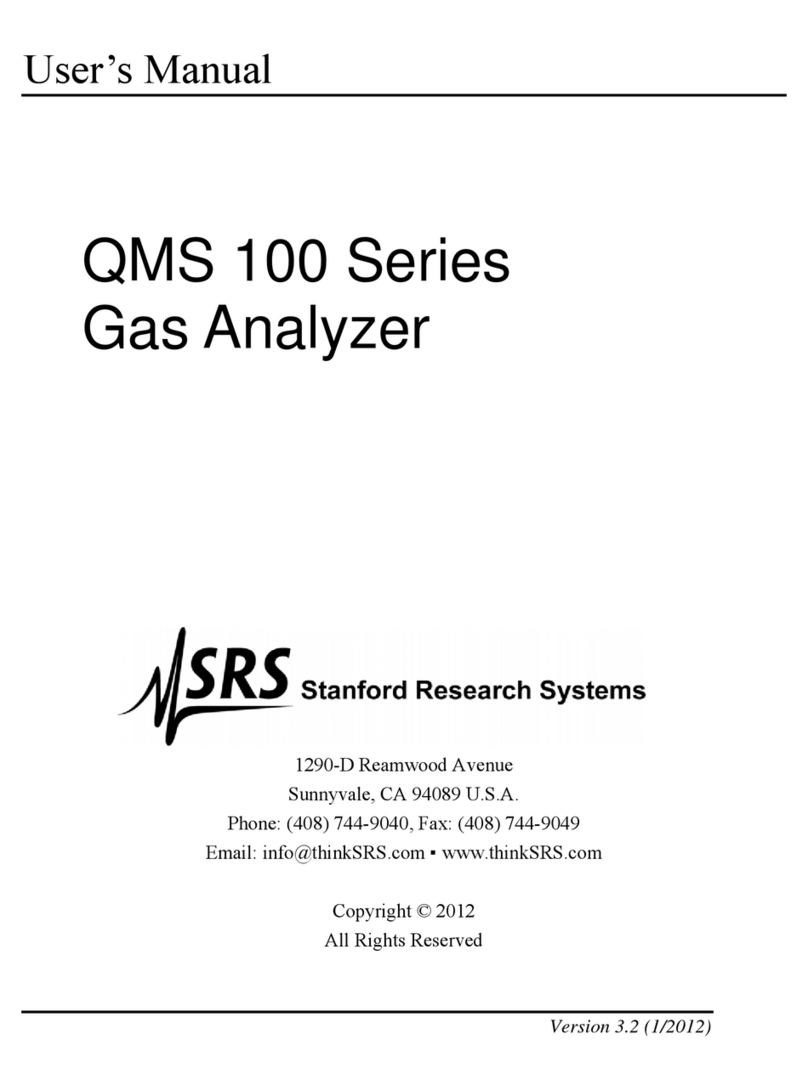
SRS Labs
SRS Labs QMS 100 Series User manual
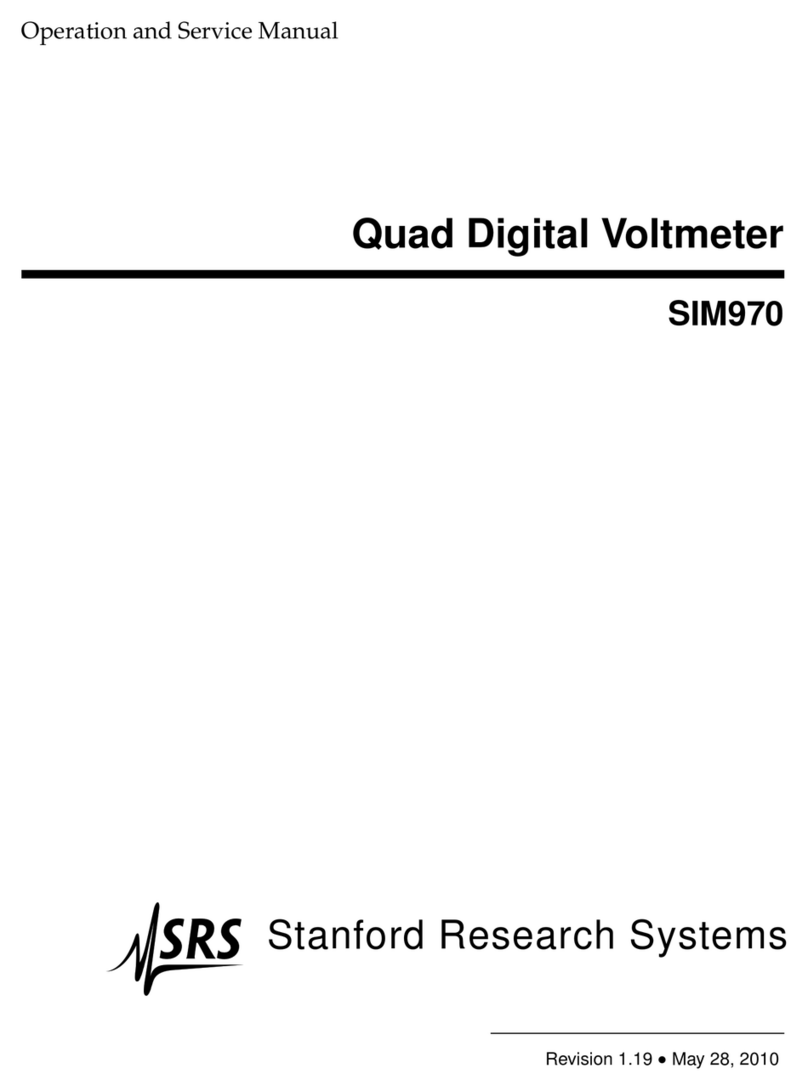
SRS Labs
SRS Labs SIM970 Operation manual
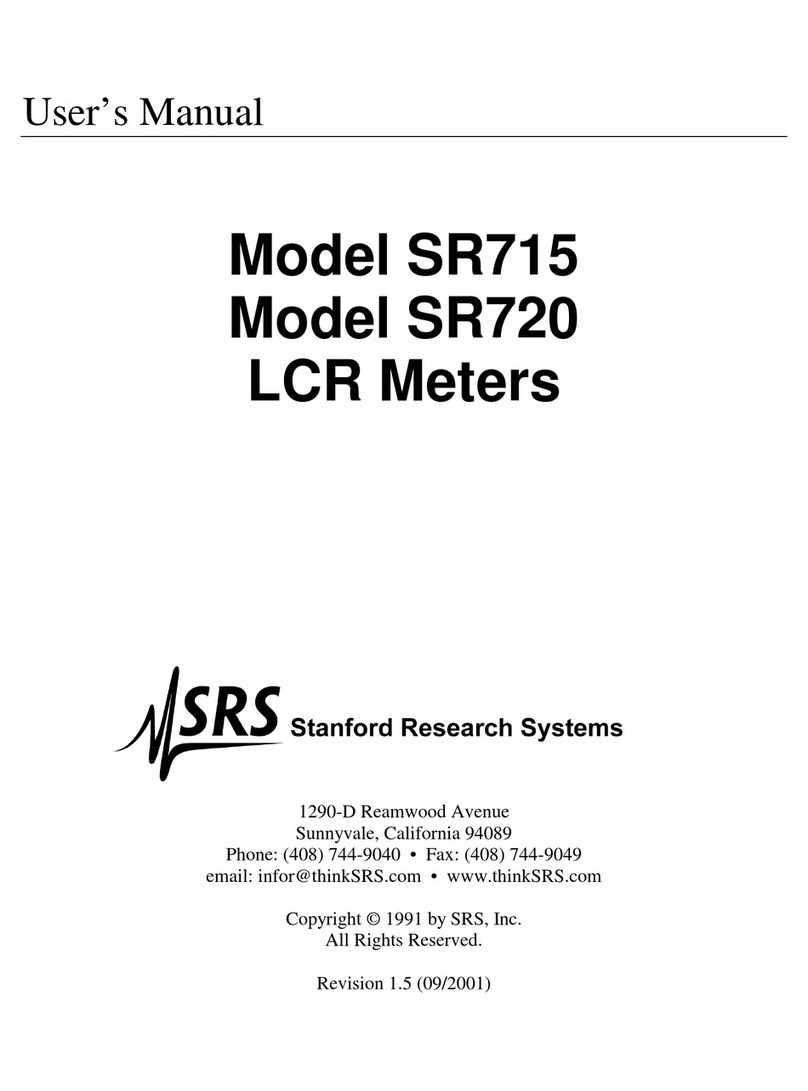
SRS Labs
SRS Labs SR715 User manual
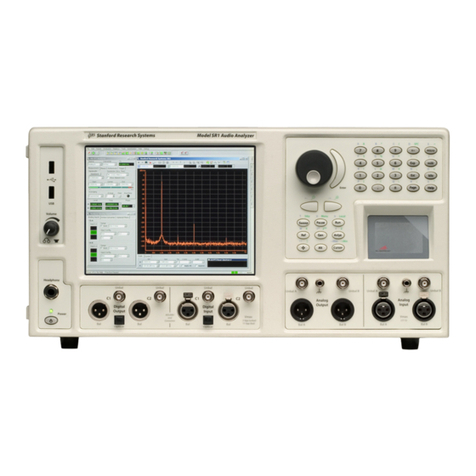
SRS Labs
SRS Labs SR1 Manual
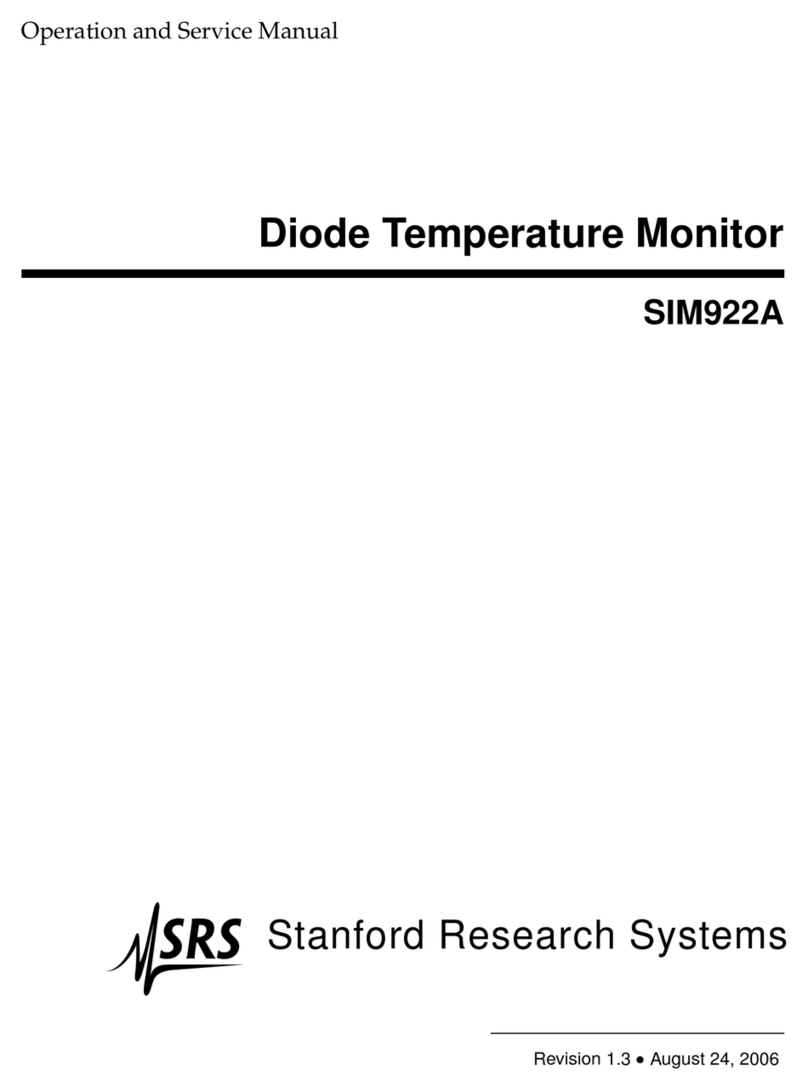
SRS Labs
SRS Labs SIM922A Operation manual
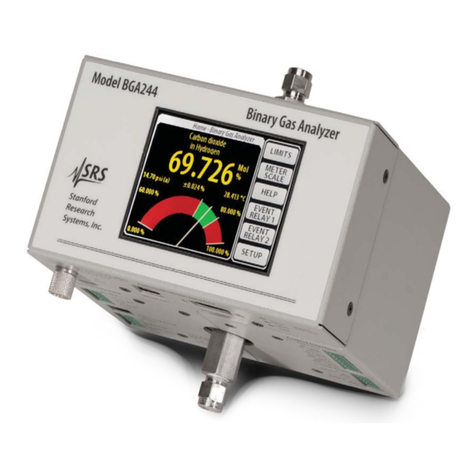
SRS Labs
SRS Labs BGA244 User manual
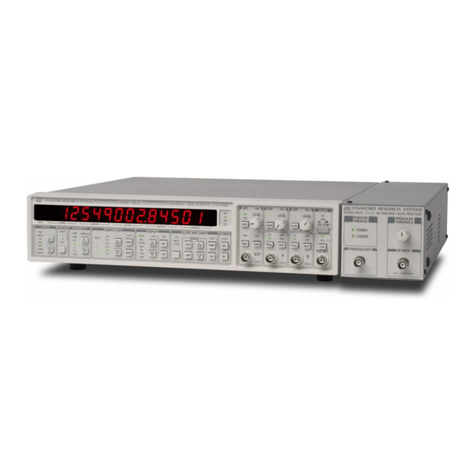
SRS Labs
SRS Labs SR625 User manual
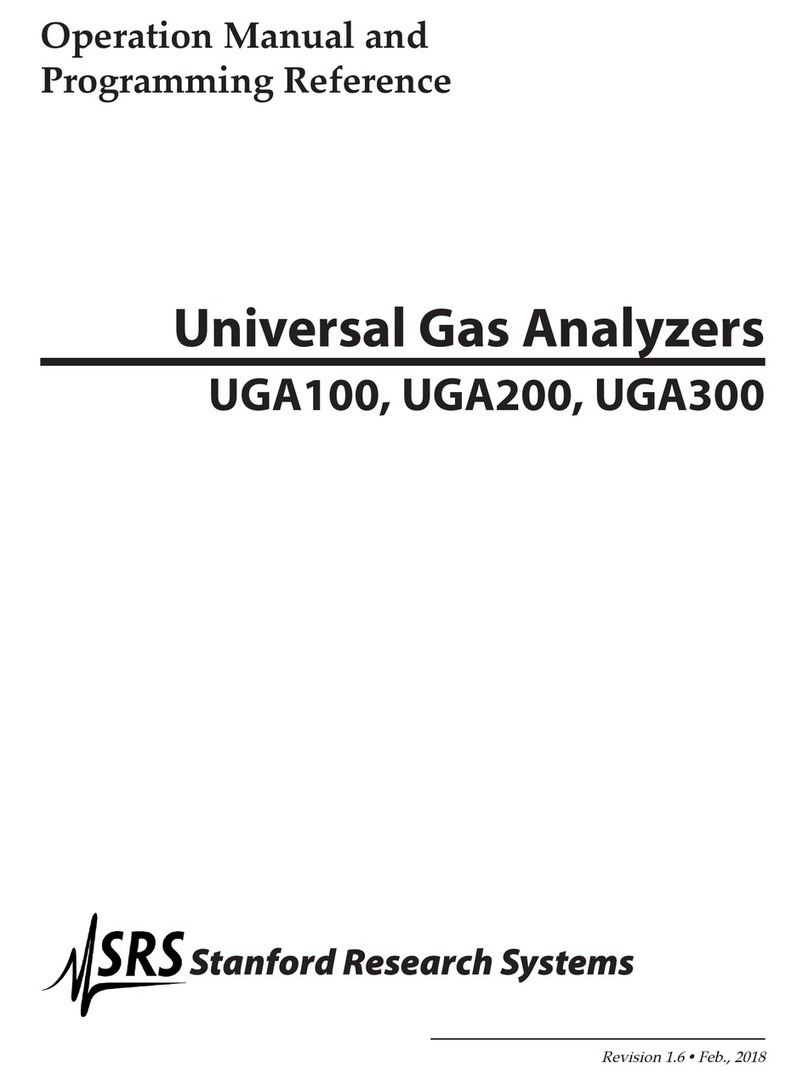
SRS Labs
SRS Labs UGA100 User manual
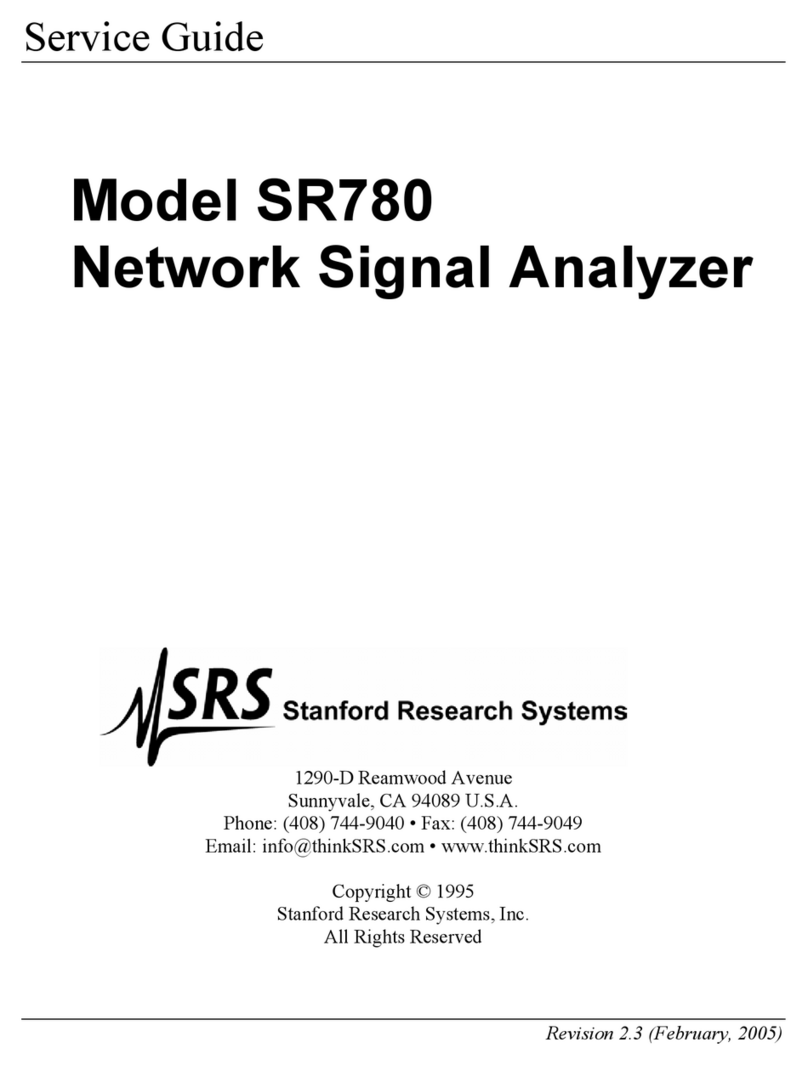
SRS Labs
SRS Labs SR780 User manual
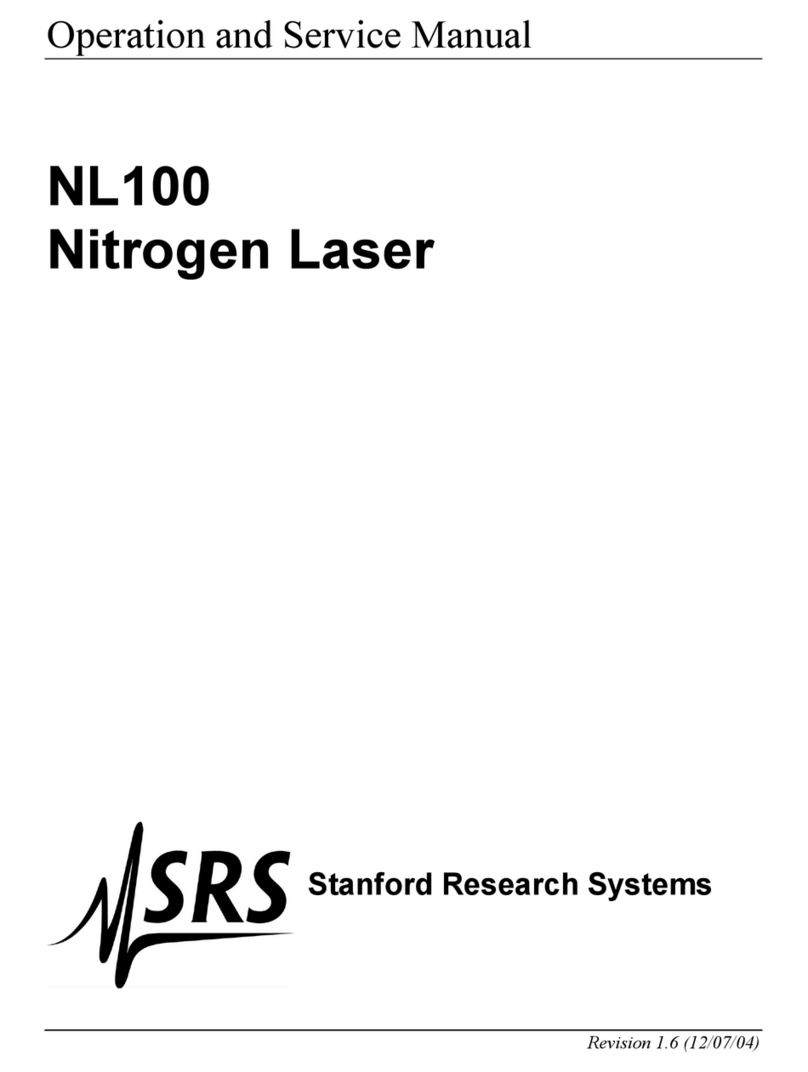
SRS Labs
SRS Labs Nitrogen Laser NL100 Operation manual
Popular Measuring Instrument manuals by other brands
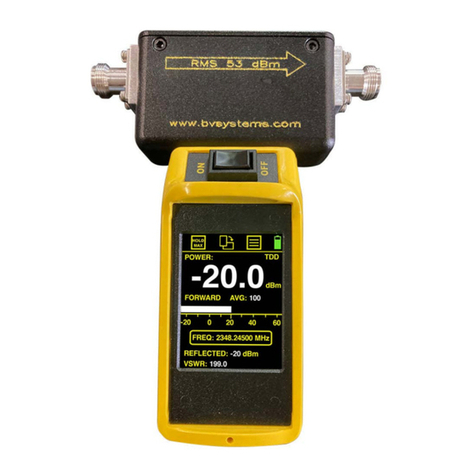
Berkeley Varitronics Systems
Berkeley Varitronics Systems YellowFrog-Pro user manual
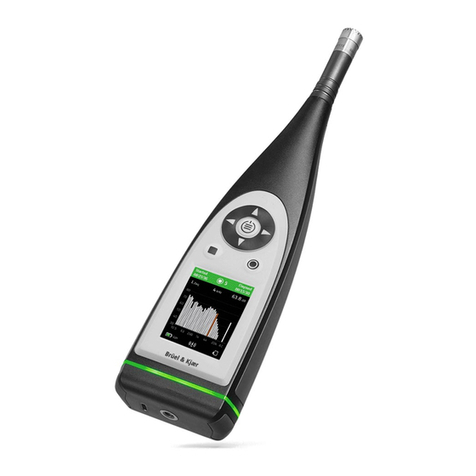
BRUEL & KJAER
BRUEL & KJAER 2245 instruction manual

AEMC instruments
AEMC instruments CA846 user manual
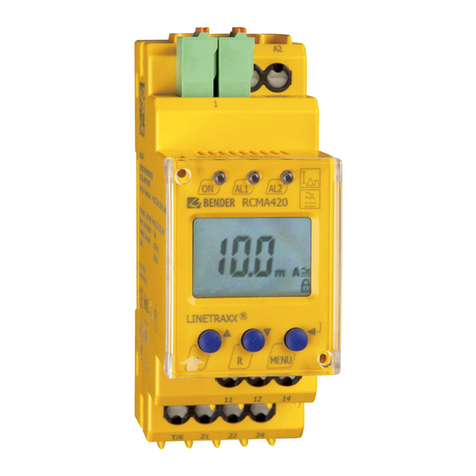
Bender
Bender RCMA420 manual
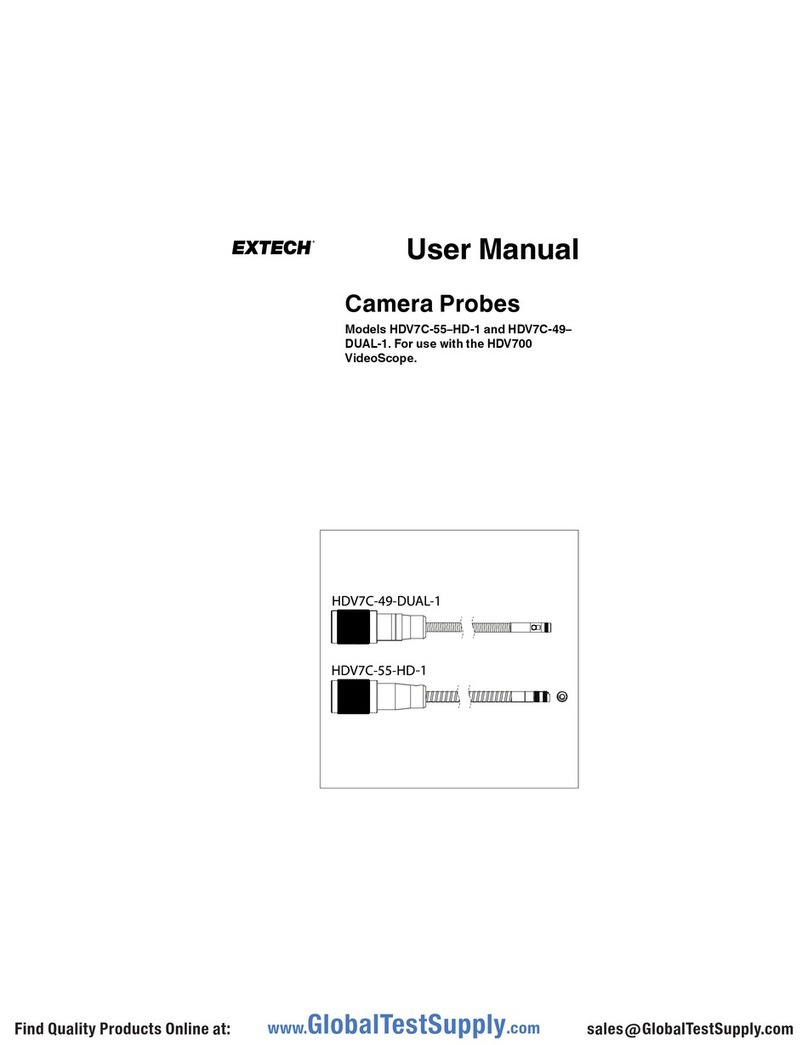
Extech Instruments
Extech Instruments HDV7C-55-HD-1 user manual
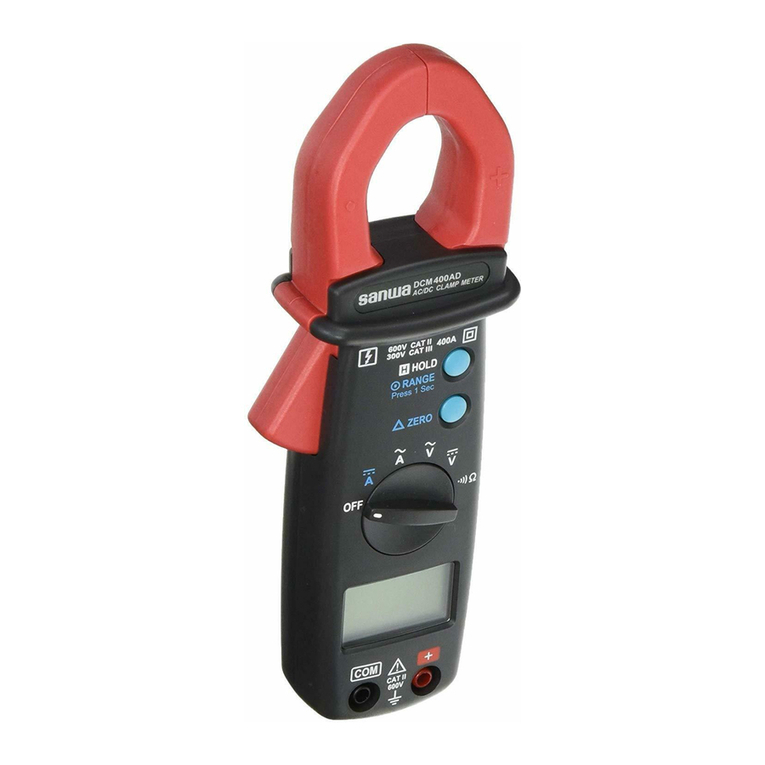
Sanwa
Sanwa DCM400AD user manual

